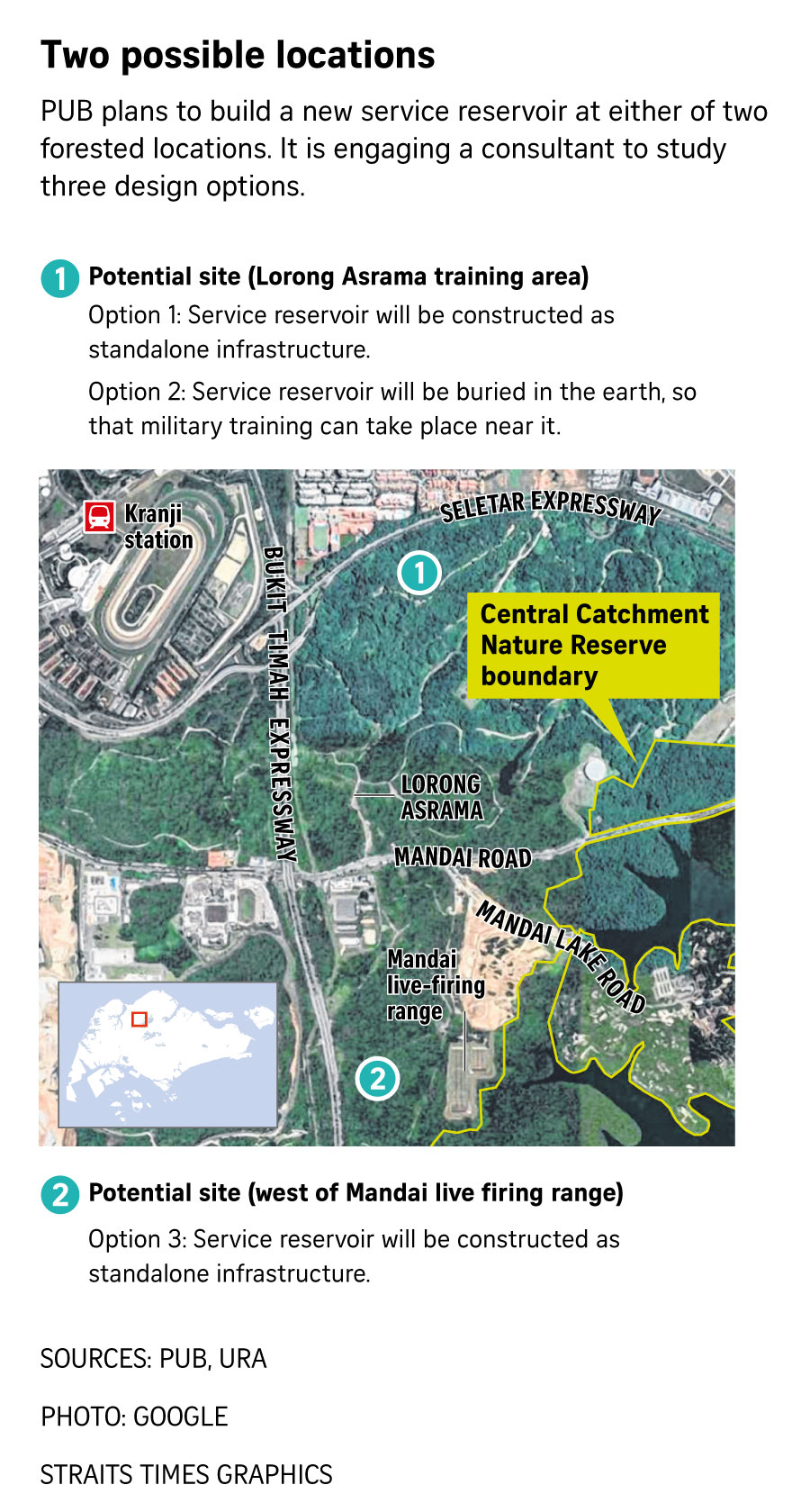SINGAPORE – National water agency PUB is planning to build a service reservoir – tanks that store treated drinking water before it is piped to consumers – over four years from 2029 to meet a projected increase in demand in north-western Singapore.
A spokesman for the agency said it will study the feasibility of tapping one of two potential sites in Mandai and determine the land area required. Both options are within forested areas.
PUB said upcoming developments in areas such as Lim Chu Kang, Sungei Kadut and Jurong Lake District are expected to boost water demand. Service reservoirs regulate supply against demand fluctuations and act as a buffer in the event of supply disruptions.
Tender documents published by PUB on Nov 25 sought a consultant for the study, with the agency saying that both sites are outside the Central Catchment Nature Reserve boundary.
Both locations are within Ministry of Defence grounds that PUB has yet to acquire.
The first is within the Singapore Armed Forces’ Lorong Asrama training area, about 1.3km from the nature reserve boundary.
The National Parks Board previously said a nature corridor – a series of green patches and connectors that are ecologically linked – would be established in the vicinity for the Kranji area.
The second site is west of the Mandai live-firing range, about 500m from the nature reserve.
When exploring potential sites, said the spokesman, PUB factored in the need for service reservoirs to be located on high ground to maintain stable and consistent pressure throughout the water supply network.
He added that PUB also chose the potential sites based on their proximity to existing pipelines, and current land use at the locations.
Should either site be found suitable, an in-depth consultation with technical agencies will be carried out to determine if an environmental study is required to look into the impact of the development and measures to address it.
Tender documents said the reservoir will have a minimum storage capacity of 60 million imperial gallons (MG), which is about 272.8 million litres and equivalent in volume to about 109 Olympic-size swimming pools.
The reservoir should also be built with provisions for its capacity to be expanded by up to 20MG, bringing its total capacity to 80MG.

An additional pipeline spanning about 8km from Mandai Road to Lentor Avenue is also being planned. The spokesman said this will allow water to be transferred from one region in Singapore to another, so that the capacities of service reservoirs can be optimised, and water supply resilience improved.
Three options will be studied for the configuration of the new reservoir, which should have tanks that will be in service for at least a century.
The first two options hinge on standalone infrastructure, at either the Lorong Asrama site or the site west of the Mandai live firing range.
The third option is to use the Lorong Asrama site and bury the reservoir in the earth so that military training can take place nearby. This option may involve re-vegetating the area above the reservoir.
All three options require a “very large” quantity of earth to be excavated, said PUB in the tender documents.
Dr Shawn Lum, a botanist at Nanyang Technological University’s Asian School of the Environment, said both forested sites have a good chance of containing some rare plants and animals.
He added that while the sites are not formally within the Central Catchment Nature Reserve, the boundary is not an ecological distinction. “They are part of the same ecosystem as the nature reserve and the delineation is a jurisdictional one,” said Dr Lum, who added that animals move freely between both sites and the nature reserve.
Acknowledging that expanding Singapore’s water storage and delivery system is important, Dr Lum said that to strike a balance between protecting nature and meeting future water needs, it will be good to know what will be lost, as well as the impact of these losses. Then, solutions that benefit biodiversity in the long term can also be planned.
He said the site west of the Mandai live-firing range contains pockets of mature, species-rich vegetation, and added that developing it will decrease the effective area of the Central Catchment Nature Reserve.
“Taken alone, its loss may not lead to local species’ extinctions, but it could push some species that much closer to the edge,” said Dr Lum, who is also president of the Nature Society (Singapore).
The Lorong Asrama site sits on the margins of a comparatively young secondary forest, he noted. “Losing this site could eventually result in a considerable reduction in the capacity of the forest north of Mandai Road to support wildlife.”
Dr Lum said that should construction proceed, a vegetation-covered reservoir would have much more biodiversity value than a vast concrete complex, adding that an option to cover a reservoir with vegetation at the site near the Mandai live firing range should also be considered.
“If planned effectively, one could even transform a vegetation-clad service reservoir roof at this site into a grassland that might support sambar deer and other wildlife that benefit from open space,” he said.
He hopes that opinions on the various options will be sought outside of PUB, possibly through workshops that also involve wide-ranging expertise to weigh the costs and benefits of each approach.
These could involve staff from other relevant government agencies, as well as landscape architects, ecologists, environmental engineers, outdoor education professionals and other stakeholders.
PUB also runs other service reservoirs across the island, including the British-built Fort Canning Service Reservoir that was commissioned in 1929, and the Tampines Newater Service Reservoir, which has two funnel-shaped tanks.


